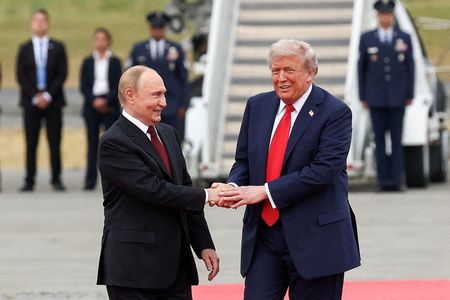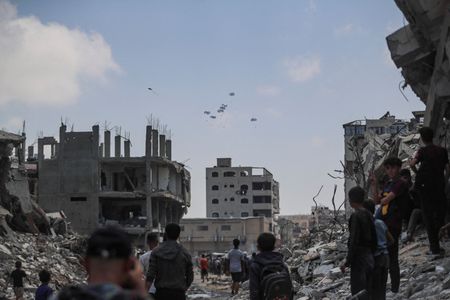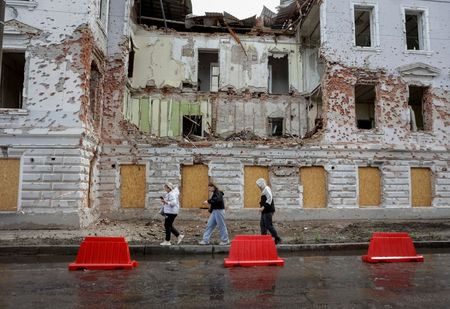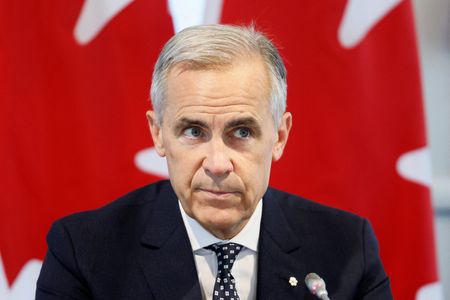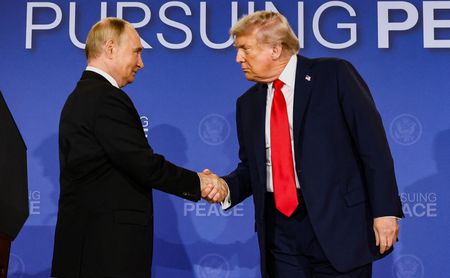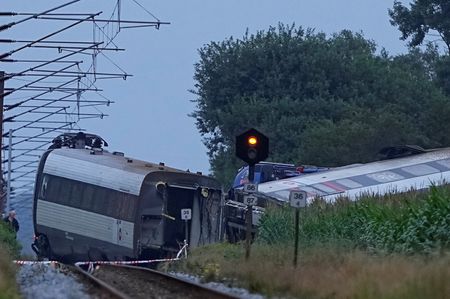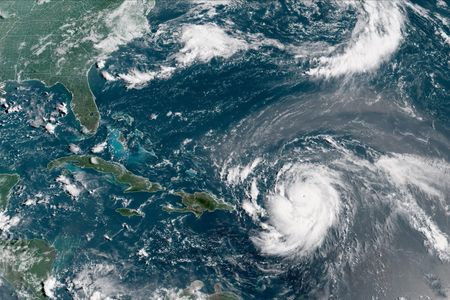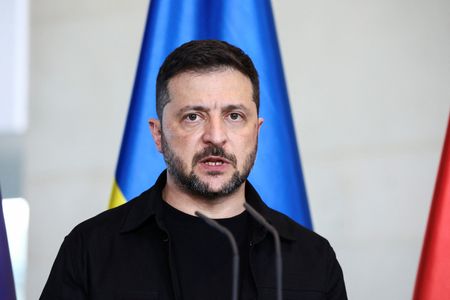By Andrew Osborn
MOSCOW (Reuters) -In a few short hours in Alaska, Vladimir Putin managed to convince Donald Trump that a Ukraine ceasefire was not the way to go, stave off U.S. sanctions, and spectacularly shatter years of Western attempts to isolate the Russian president.
Outside Russia, Putin was widely hailed as the victor of the Alaska summit while at home, Russian state media cast the U.S. president as a prudent statesman, even as critics in the West accused him of being out of his depth.
Russian state media made much of the fact that Putin was afforded a military fly-over, that Trump waited for him on the red carpet, and then let the Russian president ride with him in the back of the “Big Beast”, the U.S. presidential limousine.
“Western media are in a state that could be described as derangement verging on complete insanity,” said Maria Zakharova, Russia’s foreign minister spokeswoman.
“For three years, they talked about Russia’s isolation, and today they saw the red carpet rolled out to welcome the Russian president to the United States,” she said.
But Putin’s biggest summit wins related to the war in Ukraine, where he appears to have persuaded Trump, at least in part, to embrace Russia’s vision of how a deal should be done.
Trump had gone into the meeting saying he wanted a quick ceasefire and had threatened Putin and Russia’s biggest buyer of its crude oil – China – with sanctions.
Afterwards, Trump said he had agreed with Putin that negotiators should go straight to a peace settlement and not via a ceasefire as Ukraine and its European allies had been demanding – previously with U.S. support.
“The U.S. president’s position has changed after talks with Putin, and now the discussion will focus not on a truce, but on the end of the war. And a new world order. Just as Moscow wanted,” Olga Skabeyeva, one of Russian state TV’s most prominent talkshow hosts, said on Telegram.
Russia launched its full-scale invasion of Ukraine in February 2022, saying Kyiv’s embrace of the West had become a threat to its security, something Ukraine has dismissed as a false pretext for what it calls a colonial-style land grab.
The war – the deadliest in Europe for 80 years – has killed or wounded well over a million people from both sides, including thousands of mostly Ukrainian civilians, according to analysts.
NO ECONOMIC RESET
The fact that the summit even took place was a win for Putin before it even started, given how it brought him in from the diplomatic cold with such pomp.
Putin is wanted by the International Criminal Court, accused of the war crime of deporting hundreds of children from Ukraine. Russia denies any wrongdoing, saying it acted to remove unaccompanied children from a conflict zone. Neither Russia nor the United States are members of the court.
Dmitry Medvedev, Russia’s former president and a close Putin ally, said the summit had achieved a major breakthrough when it came to restoring U.S.-Russia relations, which Putin had lamented were at their lowest level since the Cold War.
“The mechanism for high-level meetings between Russia and the United States has been restored in its entirety,” he said.
But Putin did not get everything he wanted and it’s unclear how durable his gains will be.
For one, Trump did not hand him the economic reset he wanted – something that would boost the Russian president at a time when his economy is showing signs of strain after more than three years of war and increasingly tough Western sanctions.
Yuri Ushakov, Putin’s foreign policy aide, said before the summit that the talks would touch on trade and economic issues.
Putin had brought his finance minister and the head of Russia’s sovereign wealth fund all the way to Alaska with a view to discussing potential deals on the Arctic, energy, space and the technology sector.
In the end, though, they didn’t get a look in. Trump told reporters on Air force One before the summit started there would be no business done until the war in Ukraine was settled.
It’s also unclear how long the sanctions reprieve that Putin won will last.
Trump said it would probably be two or three weeks before he would need to return to the question of thinking about imposing secondary sanctions on China, to hurt financing for Moscow’s war machine.
Nor did Trump – judging by information that has so far been made public – do what some Ukrainian and European politicians had feared the most and sell Kyiv out by doing a deal over the head of Ukrainian President Vladimir Zelenskiy.
Trump made clear that it was up to Zelenskiy as to whether he would agree – or not – with ideas of land swaps and other elements for a peace settlement that the U.S. president had discussed with Putin in Alaska.
Although as Trump’s bruising Oval Office encounter with Zelenskiy showed earlier this year, if Trump thinks the Ukrainian leader is not engaging constructively, he can quickly turn on him.
Indeed, Trump was quick to start piling pressure on Zelenskiy, who is expected in Washington on Monday, saying after the summit that Ukraine had to a deal because, “Russia is a very big power, and they’re not”.
“The main point is that both sides have directly placed responsibility on Kyiv and Europe for achieving future results in the negotiations,” said Medvedev, who added that the summit showed it was possible to negotiate and fight at the same time.
DONBAS DEMAND
While deliberations continue, Russian forces are slowly but steadily advancing on the battlefield and threatening a series of Ukrainian towns and cities whose fall could speed up Moscow’s quest to take complete control of the eastern region of Donetsk, one of four Ukrainian regions Russia claims as its own.
Donetsk, some 25% of which remains beyond Russia’s control, and the Luhansk region together make up the industrial Donbas region, which Putin has made clear he wants in its entirety.
Putin told Trump he’d be ready to freeze the front lines in Zaporizhzhia and Kherson, two of the other regions he claims, if Kyiv agreed to withdraw from both Donetsk and Luhansk, a person familiar with the matter told Reuters.
Zelenskiy rejected the demand, the source said.
According to the New York Times, Trump told European leaders that Ukrainian recognition of Donbas as Russian would help get a deal done. And the U.S. is ready to be part of security guarantees for Ukraine, German Chancellor Friedrich Merz said.
Some Kremlin critics said it would be a mistake to credit Putin with too much success at this stage.
“Russia has re-established its status and got dialogue with the U.S.,” said Michel Duclos, a French diplomat who formerly served in Moscow and who is an analyst at the Institut Montaigne think-tank. “But when you have a war on your hands and your economy is collapsing, these are limited gains.”
Russian officials deny the economy, which has been put on a war footing and has proved more resilient than the West forecast despite heavy sanctions, is collapsing. But they have acknowledged signs of overheating and have said the economy could enter recession next year unless policies are adjusted.
“For Putin, economic problems are secondary to his goals, but he understands our vulnerability and the costs involved,” said one source familiar with Kremlin thinking.
“Both sides will have to make concessions. The question is to what extent. The alternative, if we want to defeat them militarily, is to mobilise resources more deeply and use them more skilfully, but we are not going down that road for various reasons,” the person said.
“It will be Trump’s job to pressure Ukraine to recognise the agreements.”
(Reporting by Andrew Osborn; Additional reporting by Darya Korsunskaya in Moscow and Layli Foroudi in Paris; Editing by David Clarke)

